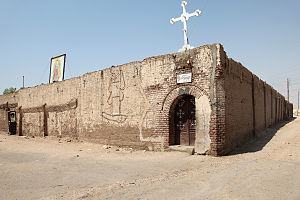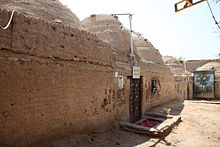 Entrance to the Monastery of the Archangel Michael | ||
| Deir el-Malāk Mīchāʾīl el-qiblī دير الملاك ميخائيل القبلي | ||
| Governorate | Qinā | |
|---|---|---|
| height | 87 m, 80 m | |
| no tourist info on Wikidata: | ||
| location | ||
| ||
The Coptic Orthodox southern monastery of the Archangel Michael (Arabic:دير الملاك ميخائيل القبلي, Dair al-Malāk Mīchāʾīl al-qiblī) is the southernmost of the monasteries between Naqada and Qamūlā. The nunnery is located in the desert west of the Nile in egyptian Governorate Qinā, about 3 km west of el-Qibli Qamula away. It will also Deir el-ʿAin (Arabic:دير العين, „Monastery of the Source") called.
getting there
The arrival from Luxor from after Qamūlā is under Qamūlā described. You are now on the desert road from Qamūlā to Naqada. The monastery is roughly at the point where the desert road turns north. A 300 m long branch to the west leads to the monastery.
The monastery is not accessible during Lent.
background
This monastery definitely existed at the beginning of the 13th century. Abū el-Makārim, of Abū Ṣāliḥ handed down to the Armenian, describes the monastery as follows: “In Qamūla there is a monastery that is named after the glorious angel Michael and is called the Monastery of the Source (Arabic: دير العين , Dair el-ʿAin) is known because there is a spring with excellent water in its vicinity, from which travelers drink when they pass this area. The monastery has a residential tower and is surrounded by a wall. And it is reported that it was the body (corpse) of St. Pisentius, superior (head) of the monastery in Upper Egypt, owns. "
After his death, St. Pisentius was probably not buried here before moving to the area of today's monastery Deir el-Anbā Pisentius was reburied.
Today's buildings date from the 14th century at the earliest.
In the south and east of the monastery there are many graves that are now abandoned.
Tourist Attractions
The 60 meter long and 50 meter wide monastery is surrounded by an enclosure wall. The entrance is in the north of the east wall. Along the north wall of the north church you get to the forecourt in the east of the churches.
The monastery has two churches. The younger church is located in the north, the older and adjoins immediately to the south. Both churches were built from air-dried bricks, but sometimes fired bricks and stone blocks with remains of Pharaonic inscriptions were used. Both churches are connected to one another via a breakthrough.
In the churches the Archangel Michael, al-Paramon, Pachomius, St. Virgin saint Georg and Tadros adored.
The southern church consists of nine domed rooms of equal size. Immediately in front of the semicircular sanctuary is the chūrus (choir) with its semicircular ends on both sides. The choir and apse thus take the form of a triconche. There is an altar each in the apse as well as in the two side rooms. The apse is accessible through two narrow doors.



The northern church dedicated to St. Is dedicated to the Virgin, has twelve domes and three sharks. Only this church is open to visitors.
kitchen
There are restaurants in the nearby Luxor or in Thebes West.
accommodation
There is accommodation in the nearby Luxor or in Thebes West.
trips
Visiting the monastery can be reduced to visiting the monasteries Deir el-Malāk Mīchāʾīl at Naqada, Deir eṣ-Ṣalīb and Deir Abū el-Līf in the village Ḥāgir Danfīq, Deir Mār Girgis el-Magmaʿ, Deir el-Anbā Pisentius and Deir Mār Buqṭur connect.
literature
- : The churches and monasteries of Egypt and some neighboring countries attributed to Abû Sâliḥ, the Armenian. Oxford: Clarendon Press, 1895, P. 283 f., Fol 104 b. Various reprints, e.g. B. Piscataway: Gorgias Press, 2001, ISBN 978-0-9715986-7-6 ..
- : Christian antiquities in the Nile Valley: a contribution towards the study of the ancient churches. Oxford: Clarendon Pr., 1912, Pp. 121-123, plate XXXVI on p. 122.
- : Dayr al-Malāk Mīkhāʾīl (Qamulah). In:Atiya, Aziz Suryal (Ed.): The Coptic Encyclopedia; Vol. 3: Cros - Ethi. new York: Macmillan, 1991, ISBN 978-0-02-897026-4 , Pp. 827-828.

